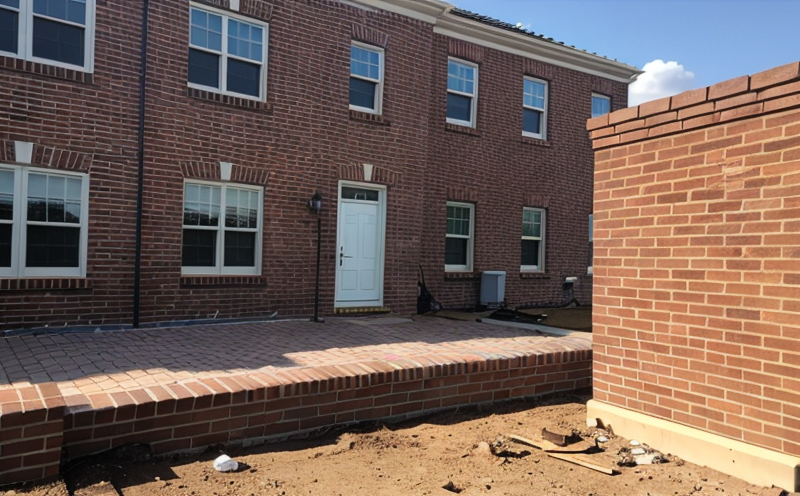ASTM C140 Sampling and Testing of Brick Units
The ASTM C140 standard provides a comprehensive framework for sampling and testing brick units to ensure they meet specified performance criteria. This method is widely used in the building and construction industry, particularly for quality assurance and compliance with international standards.
ASTM C140 involves several critical steps that must be followed rigorously to obtain accurate results. The process begins with proper sampling of brick units from a production batch or shipment. It is essential to ensure that the sample is representative of the entire batch, as this will directly impact the validity and reliability of the test results.
Once the bricks are sampled, they undergo testing for various properties such as compressive strength, water absorption, thawing frost resistance, and durability under freeze-thaw cycles. Each property provides crucial insights into the brick's performance in different environmental conditions, which is vital for ensuring long-term structural integrity.
The methodology outlined in ASTM C140 ensures that all tests are conducted using standardized procedures to minimize variability and ensure consistency across different laboratories. This standardization is particularly important when comparing results from various testing facilities or when quality control measures need to be enforced uniformly.
For instance, compressive strength testing involves placing the brick specimen under a gradually increasing load until failure occurs. The maximum load at which the specimen fails indicates its compressive strength. Similarly, water absorption is determined by immersing the brick in water for a specified period and measuring the weight gain after drying.
The freeze-thaw resistance test simulates environmental conditions that bricks might encounter over their lifespan. Bricks are subjected to cycles of freezing and thawing while immersed in water, followed by drying. The degree of mass loss or strength reduction during these cycles indicates the brick's durability under extreme weather conditions.
ASTM C140 sampling and testing is a critical process that helps manufacturers ensure their products meet the required quality standards. By adhering to this standard, construction professionals can confidently use bricks that are reliable and durable in various applications.
Scope and Methodology
The scope of ASTM C140 covers the sampling procedures for brick units as well as the testing methods to evaluate their properties. The standard specifies the steps involved in selecting a representative sample from a batch or shipment, ensuring that no biases are introduced during this process.
Following proper sampling, the test methods outlined in ASTM C140 provide detailed instructions on how to conduct various tests such as compressive strength, water absorption, and freeze-thaw resistance. These tests are designed to evaluate different aspects of brick performance under specific conditions.
- Compressive Strength: This test measures the maximum load a brick can withstand before failing in compression. It is crucial for assessing the structural integrity of bricks used in load-bearing applications.
- Water Absorption: Water absorption tests determine how much water a brick can absorb, which is important for understanding its potential to retain moisture and contribute to mold growth or freeze-thaw damage.
- Freeze-Thaw Resistance: This test evaluates the brick's ability to withstand repeated cycles of freezing and thawing. It simulates real-world environmental conditions that bricks may encounter, ensuring their durability over time.
Benefits
Implementing ASTM C140 sampling and testing offers numerous benefits to both manufacturers and end-users of brick units. These include:
- Quality Assurance: Ensures that only bricks meeting the specified performance criteria are used in construction projects, leading to higher quality structures.
- Regulatory Compliance: Helps manufacturers comply with local and international standards, avoiding potential legal issues associated with non-compliance.
- Risk Mitigation: Reduces the risk of using substandard materials that could lead to structural failures or other complications in construction projects.
- Consistency Across Batches: Ensures consistent quality across different batches, allowing for reliable performance of bricks even when sourced from various suppliers.
- Environmental Sustainability: Promotes the use of durable and reliable materials that can withstand harsh environmental conditions, reducing the need for frequent replacements.
Customer Impact and Satisfaction
The implementation of ASTM C140 sampling and testing has a significant impact on customer satisfaction in the building and infrastructure sector. By ensuring that only high-quality bricks are used, customers can expect:
- Improved Structural Integrity: Structures built with ASTM-compliant bricks are more likely to withstand environmental stresses without compromising their structural integrity.
- Enhanced Durability: The freeze-thaw resistance test ensures that bricks can endure harsh weather conditions, leading to longer-lasting structures.
- Increased Confidence in Suppliers: Compliance with ASTM standards demonstrates a commitment to quality and reliability, fostering trust between suppliers and customers.
- Reduced Maintenance Costs: High-quality bricks require less maintenance over their lifespan, resulting in cost savings for building owners and operators.





